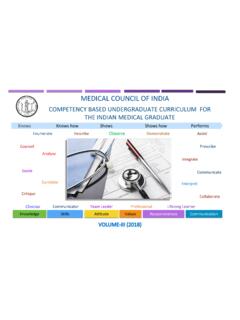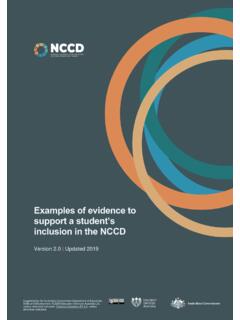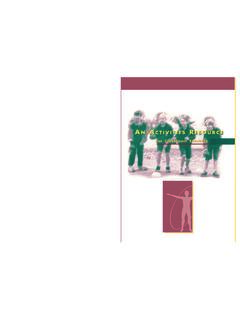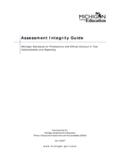Transcription of Teachers’ Manual for
1 Teachers Manual for ECCE & Early Grades Directorate of School Education Kashmir Table of Contents Particulars Page Part -I Introduction to the Manual 7 Child Friendly Schools and Learning 8 Understanding the Concept of Child and Childhood 11 Holistic Development and Domains 13 Part -II Examples of weekly theme based lessons plans 17 Theme : Myself 19 Theme : Me and my Family 22 Theme Fruits 28 Theme: Vegetables 32 Theme: Seasons 35 Theme : Flowers 39 Theme : Animals and Birds 42 Theme : Transport 48 Theme : Food 51 Theme : Plants & trees 52 Part III Suggested guidance for classroom management 54 Adapting the Manual to teach in different situations 56 Approach to teaching English across all grades 57 Concepts and age group specific activities for maths 61 Annexure Profile & Progress Report (Format) Government of Jammu & Kashmir Directorate of School Education Kashmir MESSAGE It is a matter of great pleasure that in association with UNICEF, we are bringing forth a teacher Manual for Kindergarten classes in order to implement the programme of Early Childhood Care & Education (ECCE) in our schools.
2 ECCE is a programme for the holistic development of the children. It supports children in the age group of 0-8 years in their learning which includes the physical, mental, linguistic, cognitive and socio-emotional development, in addition to their health, nutrition, health and hygiene. This includes the infancy period from (0 to 2+) years, the pre-school period (3-6) years and two years of early primary period. The Manual designed by a team from UNICEF, SSA and the Innovation Cell at the Directorate of School Education Kashmir, is based on the Theme Based Approach of Learning that helps to nourish the different developmental domains in a child. The teaching in the early grades as per this Manual would boost the child centric playful learning among the children in our schools. We hope that our teachers can use this Manual judiciously for benefiting children in early grades as these are the formative years of the child and need to be handled carefully.
3 We are thankful to the UNICEF team for their expertise and technical support in making this Manual a reality. Dr. Shah Faesal (IAS) Director School Education Kashmir FOREWORD The state of Jammu and Kashmir (J&K) is making substantial efforts towards providing quality schooling to the state s children through its various programmes and policies. Under Sarva Shiksha Abhiyan (SSA) efforts include strengthening of school infrastructure, building teacher capacities as well as improving teaching-learning methods and materials to enhance learning outcomes amongst the children of Jammu and Kashmir (J&K). The state sees a clear link between improved teacher training, quality classroom transaction and children s learning outcomes. Like many other states in the country J&K recognises that enabling teachers to adopt child-centred, activity based teaching methods as articulated in the National Curriculum Framework (2005) needs significant efforts and time.
4 Further, in Jammu and Kashmir there is a pre-primary class at the primary stage. It is hoped that this will help children adjust to school life, develop a strong base for learning and increase the enrolment in government schools. Importantly, this also helps meet parental aspirations of seeing their children enrol in a good pre-school around age 3 or 4. However, the pre-primary class needs to be integrated with a school system that is able to provide the young children with age appropriate learning environment, and teachers need the right skills and competencies to address the learning needs of young children. In this context, UNICEF has offered to collaborate with the state to strengthen different aspects of elementary education, with an emphasis on improving teaching learning practice in the early grades, beginning with the pre-primary section and up to grade III within the primary school. The importance of children s learning in the early grades is well established in research throughout the world.
5 During these years (ages 3 to 8), children s brain development and their ability to absorb and learn from their environment, in the areas of language and cognitive development are at their peak. If the teacher is able to offer developmentally appropriate learning opportunities during these years, children are able to build strong and long lasting neural connections, creating an academic foundation that lasts them a lifetime. Children who receive the right inputs in the early grades are much more likely to succeed in later years of school, increasing chances of school completion and decreasing the chance of drop out. Taking this further, it has been agreed that a collaborative effort involving the State Government, UNICEF and Save the Children will be made over a period of three years starting 2015. Through these efforts, the state will develop resources for teachers which will enable them to progress towards the objective of Child Friendly Schools in Jammu and Kashmir.
6 As a part of this collaboration UNICEF has worked with Sarva Shiksha Abhiyan, Innovation Cell at the Directorate of School Education Kashmir, State Institutes of Education (Jammu and Srinagar), District Institutes of Education and Training and selected school teachers and subject experts to create this teachers Manual and the accompanying 5 day training programme for teachers. 6 | Teachers Manual for ECCE and Early Grades PART I 7 | Teachers Manual for ECCE and Early Grades INTRODUCTION TO THE Manual The Manual consists of III parts as follows: I. Key Concepts and Principles: - Child Friendly School Systems, - Nature of Children and Learning in the Early Years and the - Need for Developmentally Appropriate Classroom Practice II. Theme based weekly plans for the Pre Primary Section - Theme Based teaching - Weekly Plans for 10 selected themes: Myself, My family, Fruits, Vegetables, Flowers, Animals & Birds, Transport, Festivals, Plants and Trees, Food III.
7 Suggestions to teachers on organization and management of activities - Adapting the Manual for all classes from pre-primary to Grade III - Approaches to teaching English and Maths for different age groups The Manual contains both theoretical concepts and principles as well as practical lesson plans and activities that teachers can adopt in their schools. This is a guiding Manual to give ideas to teachers; teachers can make changes as per the local context and need. Teachers are advised to read the Manual carefully, understand the principles and ideas and prepare themselves accordingly. Further this is a Draft Manual and will be revised after inputs from Resource Persons and Teachers. How to use the Manual Read: Read the Manual and understand its objectives. As a teacher it is essential that you understand and agree to the concept of child-centred, developmentally appropriate and active learning approach.
8 Make Notes: After reading the Manual , it is essential that you make your own notes; these will help you to plan ahead for classroom management and conduct the lessons as well as. Prepare: Each thematic plan gives details of the material needed, be ready with material that you are going to need for the various activities. 8 | Teachers Manual for ECCE and Early Grades CHILD FRIENDLY SCHOOLS AND LEARNING To promote a supportive learning and growing environment, UNICEF and many other agencies across the world have promoted the Child Friendly and Protective Schools framework. This framework promotes the belief that schools should be Open and welcoming to all children School does not passively receive but actively seeks children Enables children to stay in school, attend regularly Ensures completion and learning with quality for every child These principles of Child Friendly Schools are also embodied in the National Curriculum Framework (2005) and are universally accepted to promote the best interest of children.
9 They value the needs of the child (respect and understanding of the child s social, psychological and academic needs), the importance of democratic participation of all children (giving space to all children to participate, speak, ask questions, choose activities) and inclusiveness (recognizing and addressing diversity in the classroom, this may be diversity of gender, age, social background, language, physical/mental needs, etc.) Children experience their school through: 1. Physical Infrastructure and Environment 2. Teaching Learning Material and Methods 3. Relationships in and around School Therefore, the principles of child friendliness have to be embodied by all the three above sites of experience. The three key features of child centeredness, democratic participation and inclusiveness can be achieved only when they are addressed throughout the school system. They have to be reflected in policies (for example, State level decisions on curriculum, text books, school calendar, teacher support etc.)
10 And through community and civil society partnerships (for example the present partnership of UNICEF with SSA, or local Self Help Groups that contribute in cooking the Mid-Day Meal, or parents/ grandparents participating in school activities). And in the same way, they must be reflected in school environment ( safe, hygienic, clean and accessible buildings), learning environment (clean accessible classroom, availability of books and other learning materials, print rich environment in the early years, acceptance of home language and culture) and through improved learning outcomes, which may be achieved through better support to teachers to understand developmentally appropriate, child centred practices. The Concept of Child Friendly Schools and Systems (CFSS) is summarized in the following diagram: 9 | Teachers Manual for ECCE and Early Grades When we follow the principles of Child Friendly Schools, we accept that: - The challenge in education is not simply to get children into school, but also to improve the overall quality of schooling and address barriers to participation.


![A NOVEL TEACHER EVALUATION MODEL 1 Commented [AF1]](/cache/preview/e/4/4/2/1/3/c/f/thumb-e44213cf73a7f1d5edae6ca83d79c07d.jpg)




